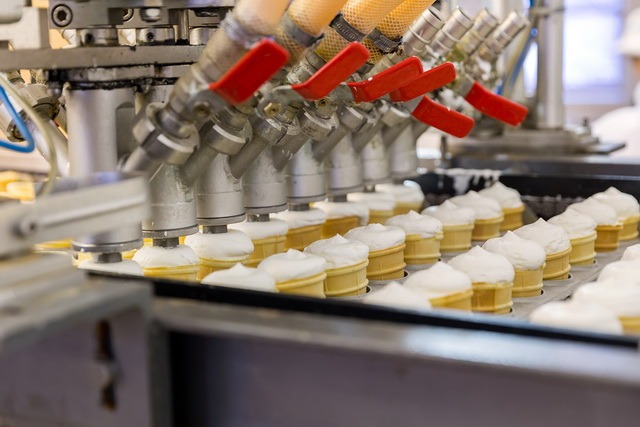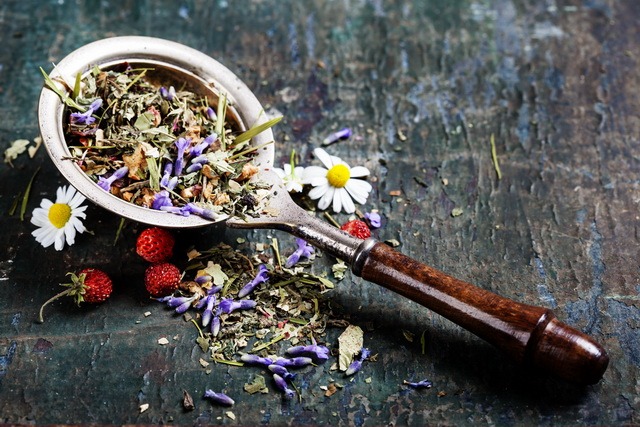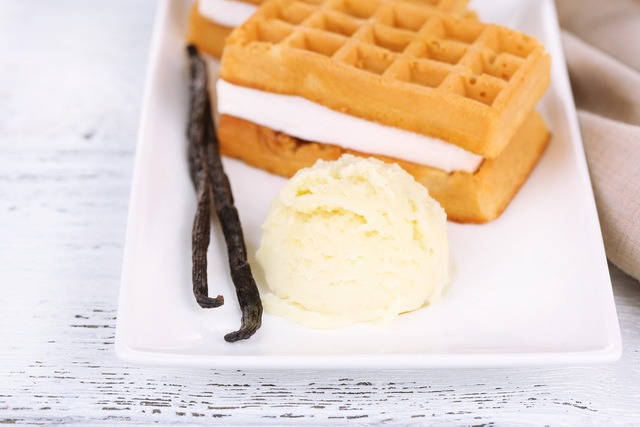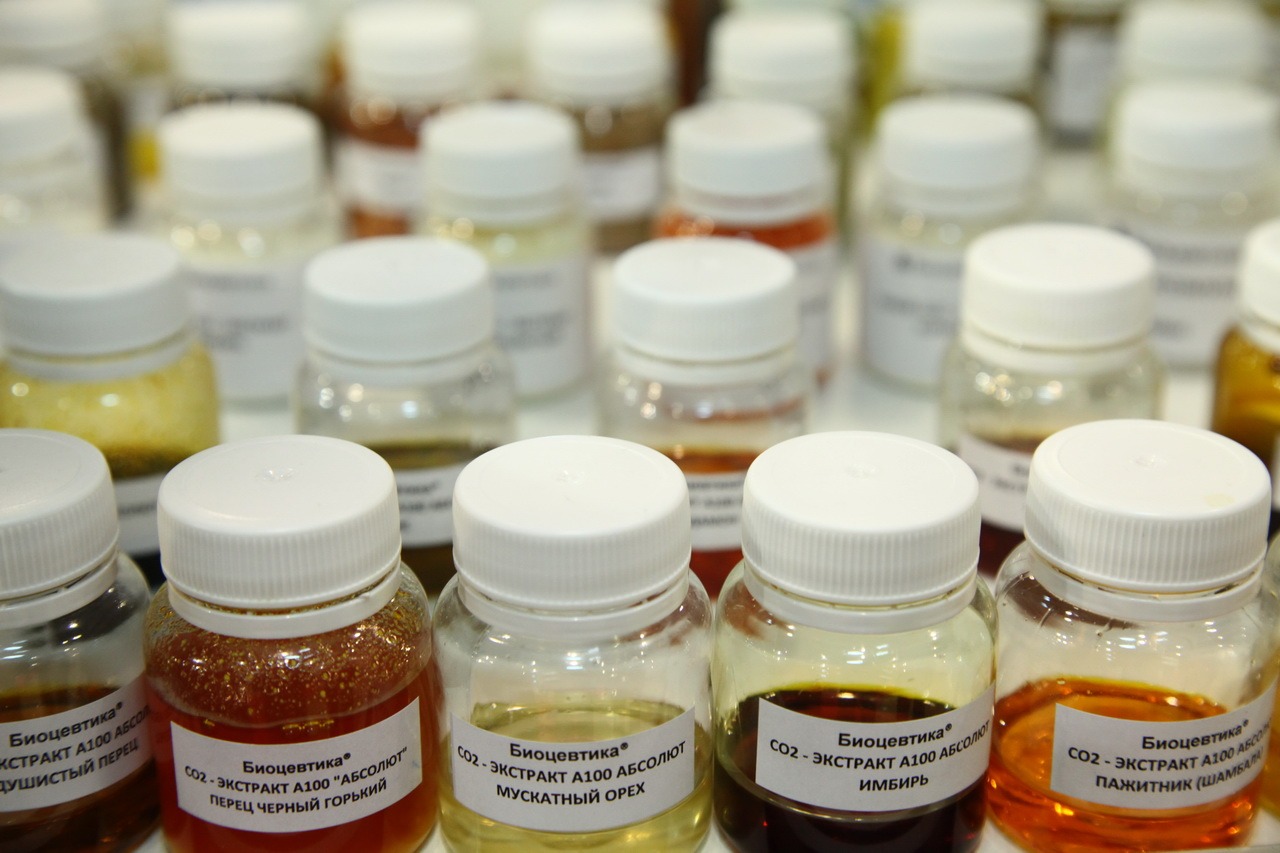CO2 extract is a product of cold technology, the parameters of which (pressure and temperature) are selected in such a way that the entire bouquet of extractable substances is fully preserved in its original, native form.
Due to the low temperature of the technological process (not exceeding 30 degrees Celsius), during extraction with liquid carbon dioxide (CO2 extraction) there is no destruction of biologically active substances, and all of them completely go into the final product (CO2 extract), which gives him many gives useful properties.
The CO2 extract also imparts the taste and smell of the original plant material to the smallest nuances – one of the stages of the technological process is a sharp depressurization (“explosion”), during which the walls of the plant cells are destroyed, resulting in the extraction of extractables Substances is greatly facilitated. This allows the entire aroma-flavor matrix of the starting material to enter the CO2 extract completely without a single exception (but under a condition that will be discussed below).
Lipophilic nature of CO2 extraction
A characteristic of CO2 extraction is that liquid carbon dioxide, which acts as an extractant, is a non-polar solvent – hence our technology extracts only its fat-soluble (lipophilic) component from plant-based raw materials. The water-soluble (hydrophilic) component of biologically active substances does not go into the CO2 extract and remains almost entirely in the CO2 grist.
CO2 extract is a complex of fat-soluble compounds

Due to this property, the main area of CO2 extraction is the extraction of such plant materials, where the most valuable from the point of view of further use are precisely fat-soluble compounds – mainly various spices, herbs, flowers, essential oil plants (but not fruits) and berries, for which taste and odor are water-soluble compounds responsible). Read more about CO2 extracts here.
Unlike the usual fruits and berries that abound in the ice cream market, CO2 extracts open up the possibility of intervening in the commercial circulation and launching entirely new flavors and flavor combinations, unusual for this market, that are accessible to the consumer are interesting and different from banal fruits and berries that all your competitors have.
The full range of CO2 extracts produced by Biozevtika for the food industry can be found at this link. In addition, if you are thinking of adding functional properties to your product, you can go through the list of CO2 extracts for cosmetics and dietary supplements. And to make it easier for you to find your way around the extensive list, we have summarized the most suitable CO2 extracts for ice cream in a small table below – of course this is only an entry-level range. In addition to those listed below, you can also choose any other CO2 extract for your product, there are no restrictions on this.
Range of CO2 extracts for ice cream production

CO2 extract and ice cream, two cold products, go together perfectly. All valuable substances obtained through the cold extraction and the exact flavor and aroma matrix are completely transferred to your product and are not destroyed by the subsequent heat treatment. The organoleptics of the product will not suffer either – the lipophilic CO2 extract is ideally mixed into ice cream.
Flowers: chamomile, lavender, rose, violet
Herbs: mint, basil, sage, lemongrass
Dessert condiments: cinnamon, cardamom, black coffee, vanilla
Fragrant condiments: allspice, cloves, thyme, rosemary
Roots, Peels, Nuts: Ginger, Lemon Zest, Orange Zest, Nutmeg
Spices: red pepper, paprika, anise, badian
Amounts of CO2 extracts used

The typical application level of CO2 extract is 0.005% by weight of the finished product. In more practical units of measurement – 50 grams per ton. It is recommended to start product development with this value and then increase or decrease the dosage to achieve the desired flavor note. The typical range of filling rates is 0.001 to 0.01% by weight of the end product or 10 to 100 grams per ton, depending on the desired effect.
Where to start, what to try
Although the CO2 extracts themselves are a fairly new product for the ice cream market, the raw materials from which they are made are not that interesting for ice cream manufacturers and consumers. Many types of the raw materials listed above have been used and continue to be used to prepare everyone’s favorite cold treat – in ground form or in the form of syrups or decoctions. One such example is flower ice cream.
Flower stock has long been used by ice cream makers, primarily for the preparation of high-quality boutique ice cream flavors that are supplied to restaurants and upscale shops. As far as we know, there are no inexpensive and popular varieties of such ice cream. Which is quite understandable – the logistics of making flower decoction is such a laborious business that one can hardly speak of mass production.
CO2 extract is another thing – a sterile, compact and technological ingredient, ideal for mass production and, among all its other advantages, also has an almost unlimited shelf life in practical terms (2 years according to the document, up to 5 years in practice). With the help of such an ingredient, you can not only expand production of any scale in a short time – besides everything, you get a product with a clean label, which is very important in our time.
Clean label

All extracts manufactured by Biozevtika are certified as “food plant extract”, therefore, based on the document received, you can legitimately state, for example, “natural chamomile extract” on the label of your product, instead of inscriptions such as “identical aroma”, which discourage the consumer. natural. ” A clean label is a free and effective tool to promote your product in the marketplace.
However, it’s not just about improved logistics and broad marketing opportunities – the main advantage of CO2 extracts lies in their unmatched taste and aroma. No semi-craft brew will ever be able to match the richness of taste and smell of a CO2 extract made with highly industrial technologies. High pressure (up to 60 atmospheres) and low temperature (up to 30 degrees Celsius) allow you to extract the entire aromatic matrix without losing a single note.
Sometimes oddities happen – ice cream makers who know what chamomile broth looks like, when they see CO2 extract, the first thing they ask is “why is it green?” Answer: CO2 chamomile extract is green because it contains light yellow essential oils and dark blue chamazulene, the addition of which gives the extract a beautiful and deep emerald green color overall. All these substances are fat-soluble, so they almost do not pass into the broth, as a result of which the chamomile broth has a different color (usually light yellowish-greenish).
Unsurpassed taste and aroma

Absolute-class essential oils (especially lavender essential oil) could only be produced from CO2 extracts according to strict Soviet state standards – in contrast to conventional essential oils, which are obtained by superheated steam distillation (which inevitably loses part of the aromatic notes), CO2 -Extracts are made with cold technology and transmit all the aromatic notes of the original product completely and without loss.
Similar to the aromatic one, the flavor matrix of the starting material also converts completely into the CO2 extract. And here, too, it is not without oddities – ice cream makers, familiar with the taste of decoctions of herbs and flowers (for example, the same chamomile), are surprised to perceive the distinctive and somewhat unusual taste of the product after applying CO2 extract. Some even begin to suspect a trick, but there is no trick. The real taste of chamomile (as well as all other herbs and flowers) is CO2 extract, not a brew.
So, with the help of CO2 extracts from the company Biozevtika, you can easily decorate your entire line of products with a new and very valuable product – delicious, fragrant and completely natural flower ice cream with a clean label. This can be done quite quickly as CO2 extracts are easy to use and technologically advanced – the speed of mass production use depends solely on your efficiency.
Recommendation

If you’re thinking of adding floral ice cream to your product line, we recommend starting with the simplest and most affordable options – chamomile and lavender. These extracts are mass-produced, they are relatively inexpensive, always in stock, and the raw material base for them is well developed – there will definitely be no supply problems. Move to more expensive and rarer options for raw materials, having familiarized yourself with the topic.
Another group of ingredients commonly used in making ice cream are dessert spices such as vanilla and cinnamon, which are mainly used in ground form. However, this type of additive has not yet become widespread in the mass market, although all the ingredients in this group go well with a sweet cold dessert. The obstacle is quite objective difficulties in the logistics and storage of ground raw materials, as well as the deterioration of the organoleptic product after the addition of solid ground impurities.
But all problems with raw materials disappear as soon as you receive a compact and sterile CO2 extract from our warehouse. With such a practical and technologically advanced ingredient, you can quickly and without significant difficulties expand the production of high-quality dessert ice cream that is not only good and natural, but also tastes and smells very familiar and comforting, such as black coffee, cinnamon, vanilla. And of course all this with a clean label.
An important aspect is that many dessert spices, especially cinnamon and vanilla, have a rather bitter and even unpleasant taste of their own (especially vanilla – who tasted the pod). Such ingredients are best used precisely in the form of a light CO2 extract, into which the most delicious and aromatic from the raw materials pass, leaving everything bitter and unpleasant in the CO2 grist.
Ideal organoleptic

CO2 extracts are devoid of all the deficiencies of the starting material, but have all its advantages – excellent taste, smell and useful properties. Without violating the organoleptics of the product, they fit perfectly into the volume, evenly filling it with excellent taste and enriching it with a luxurious natural smell. In addition, due to their natural properties, CO2 extracts do not deteriorate the organoleptic properties of the product, but rather improve and extend its shelf life.
Separately, it is worth mentioning another, quite heterogeneous group of ingredients, which we combined into one category at the beginning of the article under the general name “roots, peels, nuts”. Additives in this group are characterized by the fact that they are just as good in ice cream, but just as difficult to use for different reasons.
Ginger must be constantly grated to get a fresh ingredient. The peel is qualitatively very unstable and has a bitter taste. And nutmeg gives a cold product a bad taste and smell, and also violates its organoleptic properties from extraneous inclusions. Meanwhile, the effect of using the ingredients of this group in ice cream is very valuable – ginger gives a tart taste and a slight burning sensation, the peel enriches the product with a pleasant citrus bitterness (but at the same time does not sour, unlike pulp), and nutmeg goes well with it such usual ingredients as orange and raisins.
CO2 extract in this case, as in all others, is the ideal solution to the problem of adding an ingredient and organizing mass production – all the problems related to raw materials and their shortcomings remain in the grist, and from us you get a convenient and compact ingredient that contains the richest flavor and aroma. Also, the technology for use is the same no matter what extract you choose to add to your product.
Functional properties of the product

Due to the cold production technology, CO2 extract is a “3 in 1” ingredient that imparts not only taste and smell, but also all the beneficial properties of the raw material. As a refrigerant product, ice cream completely absorbs all three qualities of the CO2 extract, i.e. in addition to taste and smell it also retains the biological activity inherent in the plant material from which the extract was made. The addition of CO2 extract automatically turns your ice cream into a functional product.
Herbs like mint and basil are also far from new to the ice cream market, but the problems that prevent their widespread use remain the same. Difficulties in logistics and storage of raw materials, cooking their own decoctions or syrups and their insufficient quality.
Logistics and storage issues are even more pronounced with herbs than with other types of problematic ingredients. Especially often unpleasant surprises await ice cream makers when working with such capricious raw materials as, for example, basil, which strives to rot at the most inopportune moment. In addition, herbs show a pronounced seasonality, which makes it even more difficult to always supply the production with raw materials of perfect and constant quality. But here, as in all other cases, CO2 extract helps again.
With the help of CO2 extract, you can get a convenient and compact ingredient of stable quality at any time and in any season, with which you can make fragrant and tasty products with a clean label in any desired quantity. Aside from synthetics, essential oil is the only natural analogue that at least remotely makes it possible to achieve something like the above. But even the essential oil is by no means a substitute for the CO2 extract, as it does not have all the necessary properties that are only inherent in the CO2 extract.
The difference between CO2 extract and essential oils

Essential oils (like peppermint essential oil) only impart the smell of the plant, not its taste. While the CO2 extract contains both taste and smell, and the smell is more complete than that of the essential oil (obtained by hot steam distillation of plant materials, inevitably losing some of the aromatic notes). CO2 extract is a more complex product than essential oil – it contains all those substances that are usually collectively referred to as “essential oil”, but there is much more besides.
Fragrant spices are already a much rarer guest on the ice cream market than the groups of ingredients mentioned above. In addition to the objective difficulties of using the ingredients of this group (such as difficulties in logistics and the production of decoctions or problems with the deterioration of the organoleptic product after the addition of ground raw materials), there are also, in our opinion, purely psychological barriers – hardly anyone comes up the idea that such spices as cloves or rosemary go well with ice cream.
There’s no reason for such neglect now—all the ingredients in this group pair surprisingly well with both cold and sweet, especially when used in pairs. Clove and allspice add a tangy flavor and a slight spiciness to your product, and both spices pair well with cinnamon and cardamom, as well as many other spices. Thyme and rosemary add a light and pleasant pine-spruce flavor to your ice cream.
But that’s not all – fragrant spices can form wonderful combinations not only with ice cream and with each other, but also with other ingredients that are often added to ice cream. For example, cloves and allspice go well with cherries and form a composition similar in taste and smell to mulled wine. And thyme and rosemary form a harmonious taste with sea buckthorn, which is characterized by a strong sweet and tart note and evokes taiga associations.
Ice cream with rosemary and other fragrant spices

Such ice cream varieties as ice cream with rosemary have been known for a long time, but they are incredibly difficult and laborious to prepare. For example, it is advisable to heat and cool a milk stock with rosemary leaves at least three times so that it absorbs enough taste and smell. The situation is similar when using other spices of this group, which makes the implementation difficulties quite large – but of course only if you do not use CO2 extracts, which solve all the problems of mass production.
And finally, a word about another group of ingredients that we classified as “spices” at the beginning of the section (although this classification is of course very arbitrary as there is no clear boundary between condiments and spices). We are mainly talking about ingredients such as paprika and chili, which are rarely found in ice cream in this country.
Meanwhile, in addition to the unusual combination of cold and hot, the taste of red pepper is very interesting and is successfully combined with the creamy taste of ice cream. Especially if you use a mixed ingredient that includes not only chili pepper but also softer and less hot paprika, it will enhance the flavor while reducing the burning, which is possibly the best option.
Anise and star anise are also suitable ingredients in ice cream, although neither one nor the other spice is particularly popular in its pure form in this country. However, if only light notes of anise and star anise are added to the product, acting as part of the composition and emphasizing other extracts, then such use of these spices is quite justified for the conditions of the Russian market. Anise and star anise also pair perfectly with traditional ice cream ingredients like pears, apples and cherries.
Cold Fire

Red pepper ice cream is widely available in a number of countries with warm climates, such as Japan, Thailand in Asia and Italy within Europe. In Italy, the greatest rush for this, by our standards, strange delicacy is in the city of Milan, where it is produced in up to 15,000 tons a year and is one of the city’s trademarks. It is believed that such ice helps to withstand the heat better. It’s hard to say how such an idea will take root in our space, so we’ll just call this option a potential opportunity.
Combinations of CO2 extracts with other ingredients used in the production of ice cream
As a side note, CO2 extracts combine well with many other ingredients traditionally used to make ice cream, such as fruits and berries. Below we provide a small table of the simplest and most basic combinations of CO2 extracts with the most typical and common other ingredients, to serve as a starting point for your own research and search for new flavors and flavor combinations. Compositions of this type, in our opinion, can be the most interesting and sought after on the market.
Apple: cinnamon, clove, anise
Pear: cinnamon, clove, anise
Cherries: Clove, Cinnamon, Allspice, Star Anise
Lemon: ginger, mint, lavender
Orange: cinnamon, cardamom, clove, nutmeg
Strawberry: mint, basil, chamomile
Sea Buckthorn: Thyme, Rosemary
Chocolate: Black Coffee, Cinnamon, Cardamom, Vanilla
Combinations of CO2 extracts with each other

As a side note, CO2 extracts combine well with many other ingredients traditionally used to make ice cream, such as fruits and berries. Below we provide a small table of the simplest and most basic combinations of CO2 extracts with the most typical and common other ingredients, to serve as a starting point for your own research and search for new flavors and flavor combinations. Compositions of this type, in our opinion, can be the most interesting and sought after on the market.
Apple: cinnamon, clove, anise
Pear: cinnamon, clove, anise
Cherries: Clove, Cinnamon, Allspice, Star Anise
Lemon: ginger, mint, lavender
Orange: cinnamon, cardamom, clove, nutmeg
Strawberry: mint, basil, chamomile
Sea Buckthorn: Thyme, Rosemary
Chocolate: Black Coffee, Cinnamon, Cardamom, Vanilla
Combinations of CO2 extracts with each other

Because of their manufacturability and ease of use, CO2 extracts make it easy to create the richest flavor compositions, the palette of which can stretch as far as your imagination allows. Such unique compositions can become a corporate identity, a unique signature of your product that differentiates it from your competitors’ products. Below in the table we give some of the simplest combinations to use as a starting point for further research.
Black coffee: cinnamon, cardamom, vanilla
Cloves: cinnamon, allspice, anise
Basil: mint, clove, allspice
Red pepper: paprika, allspice, star anise
Economy and Logistics
The ease of use in the production of compact and unpretentious storage conditions for CO2 extracts is difficult to compare with the daily hassle of delivery, handling, incoming inspection, proper storage, production-oriented processing and subsequent delivery that the production of conventional raw materials stored in bags entails .If you need to create a flavor composition in order to give your product unique, memorable and distinctive characteristics, the complexity of using conventional raw materials will increase many times – to create mixtures and grinds you need separate equipment, a separate production area and separate personnel units for the Maintenance of this technological process. With CO2 extracts, there are no such difficulties – the required mixture can be made in any production laboratory in a matter of minutes, or we can do it for you and supply you with a ready-made mixture of extracts.
Comparison of the logistics of CO2 extracts and traditional raw materials

CO2 extracts are completely natural, compact, sterile, do not contain residues of solvents and preservatives, have a long shelf life and are very unpretentious in terms of storage conditions. At the same time, CO2 extracts are easy to use, technologically advanced, ideally suited for mass production, can be easily integrated into any technological chain and are compatible with everyone.
